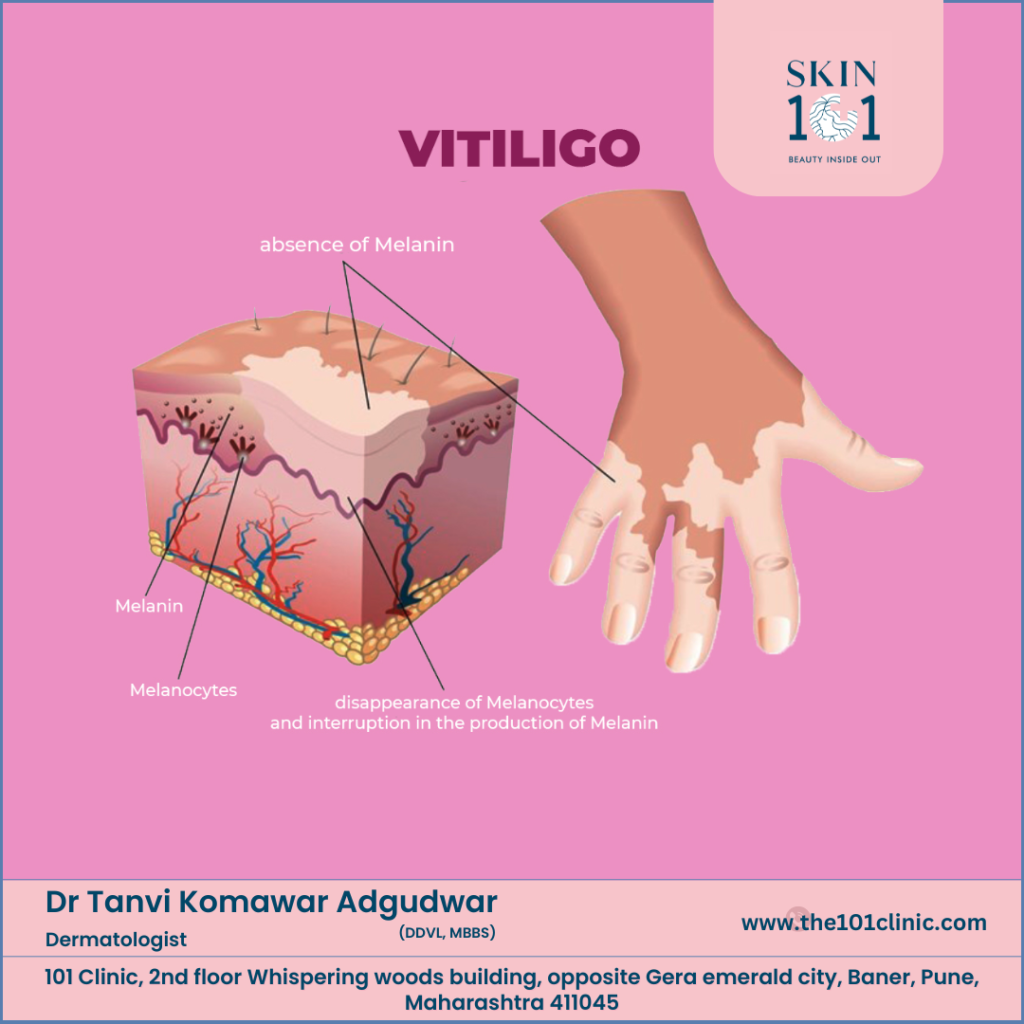Introduction: Vitiligo is a skin condition characterized by the loss of pigment, resulting in white patches on the skin. While it’s not life-threatening, vitiligo can significantly impact a person’s emotional and psychological well-being. This blog explores the types, causes, symptoms, diagnosis, and treatment options for vitiligo, offering insights for those affected by the condition.
Vitiligo: Types, Causes, Symptoms, Diagnosis, and Treatment Options
Introduction: Vitiligo is a skin condition characterized by the loss of pigment, resulting in white patches on the skin. While it’s not life-threatening, vitiligo can significantly impact a person’s emotional and psychological well-being. This blog explores the types, causes, symptoms, diagnosis, and treatment options for vitiligo, offering insights for those affected by the condition.
What is Vitiligo?
Vitiligo is a chronic skin disorder where melanocytes, the cells responsible for skin pigmentation, are destroyed. This leads to the development of white patches on various parts of the body. The condition affects people of all skin types but is more noticeable in individuals with darker skin.
Types of Vitiligo:
- Generalized Vitiligo:
The most common form, where depigmented patches appear symmetrically on both sides of the body. Common areas include the face, neck, hands, and knees. - Segmental Vitiligo:
This type affects only one side of the body or a specific area, often developing at a younger age and progressing for a few years before stabilizing. - Focal Vitiligo:
Characterized by a few scattered white patches that do not follow a specific pattern and may not spread extensively. - Acrofacial Vitiligo:
This type primarily affects the face, hands, and feet, with patches appearing around the mouth, eyes, and fingers. - Universal Vitiligo:
A rare form where nearly all of the skin loses its pigment, covering over 80% of the body.
Causes of Vitiligo:
The exact cause of vitiligo is not fully understood, but several factors are believed to contribute:
- Autoimmune Factors:
The immune system mistakenly attacks melanocytes, leading to their destruction. - Genetics:
Family history of vitiligo or other autoimmune diseases may increase the risk. - Environmental Triggers:
Sunburn, stress, or exposure to certain chemicals can trigger or worsen the condition. - Neurogenic Factors:
The release of harmful chemicals from nerve endings may also contribute to the destruction of melanocytes. - Oxidative Stress:
An imbalance between free radicals and antioxidants in the body may play a role in the development of vitiligo.
Symptoms of Vitiligo:
- White Patches on the Skin: The primary symptom, these patches can appear on any part of the body, including the mucous membranes and retina.
- Premature Graying of Hair: Hair on the scalp, eyelashes, eyebrows, and beard may turn white early.
- Color Loss in the Tissues Inside the Mouth and Nose: Some people experience depigmentation in the inner tissues.
Treatment Options for Vitiligo:
While there is no cure for vitiligo, several treatment options can help restore skin color or even out skin tone:
- Topical Corticosteroids:
These creams may help return color to white patches, especially if started early. - Topical Calcineurin Inhibitors:
Useful in areas with thin skin, such as the face and neck, these creams help reduce inflammation and the immune response. - Phototherapy (Light Therapy):
Narrowband UVB therapy is a common treatment that helps stimulate melanocyte production. It is often combined with topical treatments for better results. - Excimer Laser Therapy:
This is a more targeted form of light therapy that focuses on specific areas, making it ideal for smaller patches. - Depigmentation Therapy:
For those with extensive vitiligo, depigmentation of the remaining pigmented skin may be considered to achieve a more uniform appearance. - Surgical Options:
- Skin Grafting: Involves transplanting small sections of normal, pigmented skin to areas affected by vitiligo.
- Blister Grafting: Blisters are created on the pigmented skin, and the tops of these blisters are transplanted to depigmented areas.
- Camouflage Therapy:
Cosmetic products, such as skin dyes and makeup, can help cover up the white patches and provide emotional relief. - Psychological Support:
Counseling or support groups can be beneficial for those struggling with the emotional impact of vitiligo.
Conclusion:
Living with vitiligo can be challenging, but understanding the condition and exploring available treatment options can help manage its effects. While there’s no definitive cure, ongoing research and advances in treatment continue to improve the quality of life for those with vitiligo. If you or someone you know is affected by this condition, consulting with a dermatologist to explore personalized treatment options is the first step toward managing vitiligo.

